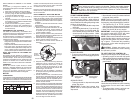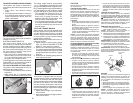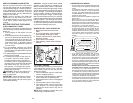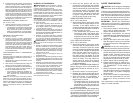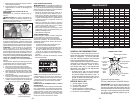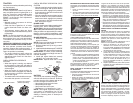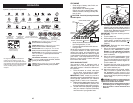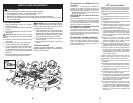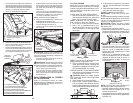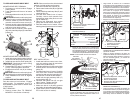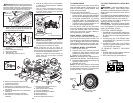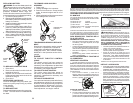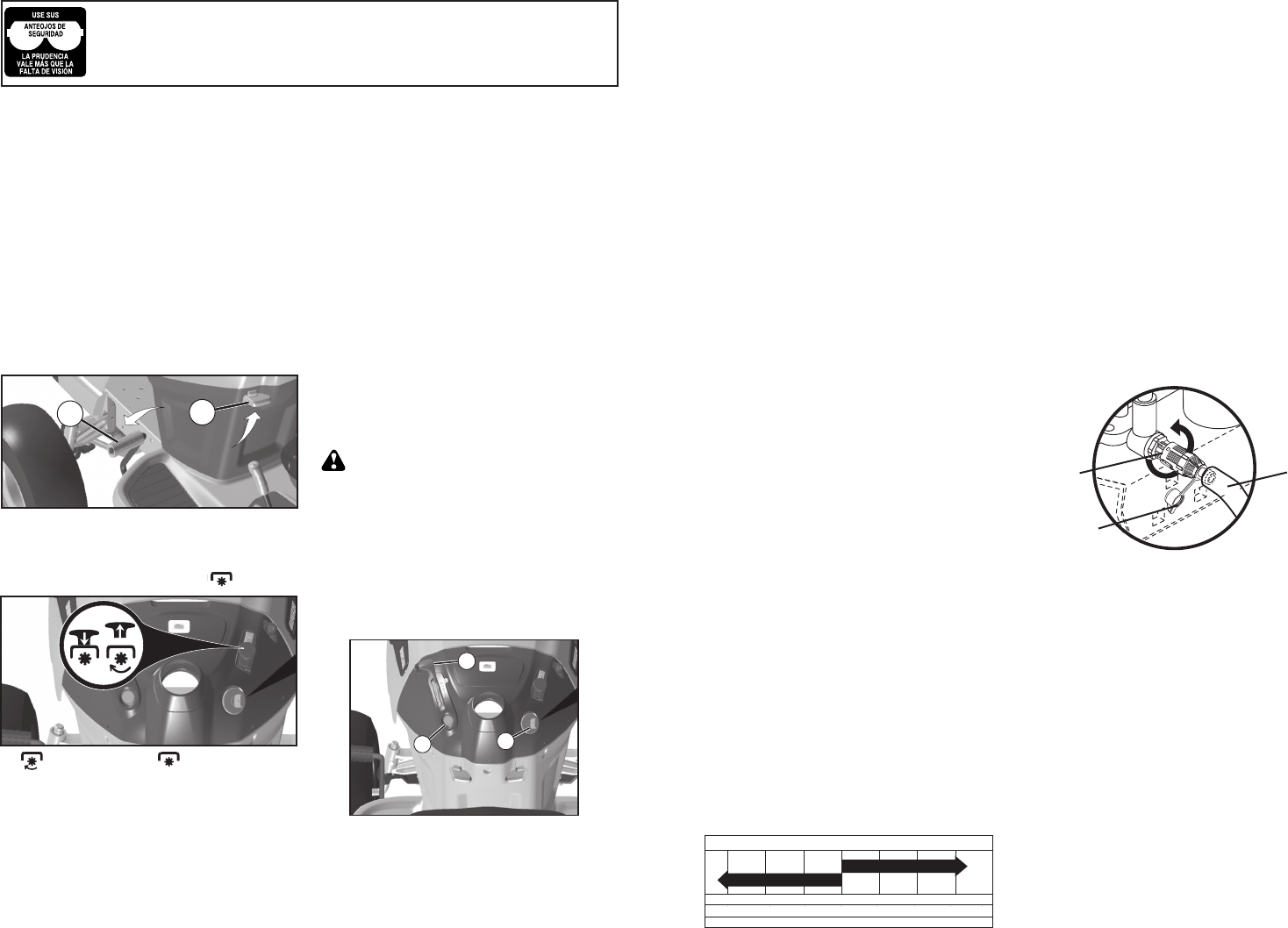
50
La operación de cualquier tractor puede hacer que salten objetos extraños dentro
de sus ojos, lo que puede producir daños graves en éstos. Siempre use anteojos
de seguridad o pro tec cio nes para los ojos mientras opere su tractor o cuando
haga ajustes o reparaciones. Recomendamos gafas de seguridad o una máscara
de visión amplia de seguridad usada sobre las gafas.
PARA USAR EL CONTROL DE LA ACELER-
ACIÓN (D)
Siempre opere el motor a una aceleración
completa.
• Si el motor funciona a una velocidad inferior a la
máxima (rápida), su rendimiento disminuye.
• El rendimiento óptimo se obtiene a la velocidad
máxima (rápida).
PARA USAR EL CONTROL DE
ESTRANGULACIÓN (N)
Use el control de estrangulación cuando esté
haciendo arrancar un motor frío. No lo use para
hacer arrancar un motor caliente.
• Para enganchar el control de estrangulación,
tire la manilla hacia afuera. Lentamente,
empuje la manilla hacia adentro para desen-
gancharlo.
COMO USAR SU TRACTOR
PARA AJUSTAR EL FRENO DE ES TA CIO NA-
MIEN TO
Su tractor viene equipado con un interruptor sen-
sor que exige la presencia del operador. Cuando
el motor está funcionando, si el operador trata de
bajarse del asiento sin primero aplicar el freno de
estacionamiento, se apagará el motor.
1. Presione el pedal (B) del freno completa-
mente y sostengalo.
2. Jale hacia arriba la palanca del freno de
mano (C) y manténgala en esa posición;
suelte gradualmente el pedal del embrague/
freno (B), y luego suelte la palanca del freno
de mano. El pedal tiene que quedar en la
posición de freno. Asegúrese que el freno
de estacionamiento va a sujetar el tractor en
forma segura.
PARADA
CUCHILLAS DE LA SEGADORA -
• Mueva el interruptor del embrague del accesorio
a la posición desenganchado (
).
IMPULSIÓN DE RECORRIDO -
• Para parar el mecanismo impulsor, presione el
pedal del freno completamente.
IMPORTANTE: Los pedales de marcha adelante
y atrás vuelven a la posición neutra cuando no
están apretados.
B
C
MOTOR -
• Mover la palanca (D) de mando entre la pos-
ición de velocidad media y máxima (rápida).
AVISO:Si no se mueve la palanca de mando
entre la posición de velocidad media y máxima
(rápida), antes de pararse, se puede causar un
“retorno de llama” del motor.
• Gire la llave de ignición (F) a la posición
de apagado “STOP” y remueva la llave al
abandonar el tractor para evitar el uso no
autorizado.
• Nunca use la estrangulación (N) para parar el
motor.
IMPORTANTE: Dejando el interruptor de la
ignición en cualquier posición otra que “STOP”
causar i que la batería se descargue (muerta).
AVISO: Bajo ciertas condiciones, cuando el trac-
tor está parado con el motor andando en vacío,
los gases de escape del motor caliente pueden
hacer que el césped se ponga “café.” Para
eliminar esta posibilidad, siempre pare el motor
cuando pare el tractor en áreas con césped.
PRECAUCIÓN: Siempre pare el tractor com-
pletamente, según se ha descrito anteriormente,
antes de abandonar la posición del operador.
D
N
F
( ) “Desenganchado”
(Disengaged)
( ) “Enganchado”
(Engaged)
23
V-BELTS
Check V-belts for deterioration and wear after
100 hours of operation and replace if neces-
sary. The belts are not ad just able. Re place
belts if they begin to slip from wear.
TO CLEAN BATTERY AND TER MI NALS
Corrosion and dirt on the battery and termi-
nals can cause the battery to “leak” power.
1. Remove terminal guard.
2. Disconnect BLACK battery cable first
then RED bat tery cable and remove
battery from tractor.
3. Rinse the battery with plain water and dry.
4. Clean terminals and battery cable ends
with wire brush until bright.
5. Coat terminals with grease or pe tro leum
jelly.
6. Reinstall battery (See “REPLACING
BATTERY" in the SERVICE AND AD-
JUST MENTS section of this manual).
TO CHANGE ENGINE OIL
Determine temperature range expected
before oil change. All oil must meet API
service classification SG-SL.
• Be sure tractor is on level surface.
• Oil will drain more freely when warm.
• Catch oil in a suitable container.
1. Remove oil fill cap/dipstick. Be careful
not to allow dirt to enter the engine when
changing oil.
2. Remove yellow cap from end of drain
valve and install the drain tube onto the
fitting.
3. Un lock drain valve by push ing in ward
slight ly and turn ing coun ter clock wise.
4. To open, pull out on the drain valve.
5. After oil has drained completely, close and
lock the drain valve by pushing inward
and turning clock wise until the pin is in
the locked position as shown.
6. Remove the drain tube and replace the
cap onto the end of the drain valve.
7. Refill engine with oil through oil fill dipstick
tube. Pour slowly. Do not overfill. For
approximate capacity see “PRODUCT
SPECIFICATIONS” section of this man u al.
8. Use gauge on oil fill cap/dipstick for
checking level. Insert dipstick into the
tube and rest the oil fill cap on the tube.
Do not thread the cap onto the tube when
taking reading. Keep oil at “FULL” line
on dipstick. Tighten cap onto the tube
securely when finished.
02463
Closed
and
Locked
Position
Oil Drain Valve
Yellow Cap
Drain
Tube
TRANSAXLE MAINTENANCE
The transmission fan and cooling fins should
be kept clean to assure proper cooling. Do
not attempt to clean fan or trans mis sion while
engine is running or while the trans mis sion
is hot. To prevent pos si ble damage to seals,
do not use high pres sure water or steam to
clean transaxle.
• Inspect cooling fan to be sure fan blades
are intact and clean.
• Inspect cooling fins for dirt, grass clippings
and other materials. To prevent damage to
seals, do not use compressed air or high
pressure sprayer to clean cool ing fins.
TRANSAXLE PUMP FLUID
The transaxle was sealed at the factory and
fluid main te nance is not required for the life
of the transaxle. Should the transaxle ever
leak or require servicing, contact your near-
est Sears or other qualified service center.
TEMPERATURE RANGE ANTICIPATED BEFORE NEXT OIL CHANGE
SAE VISCOSITY GRADES
-20 0 30 40
80
100
-30
-20 0
20 30 40
F
C
32
-10
10
60
5W-30
10W30
oil_visc_chart4_e
ENGINE
LUBRICATION
Only use high quality detergent oil rated
with API service classification SG-SL.
Select the oil’s SAE viscosity grade
according to your expected operating
temperature.
Change the oil after every 50 hours of op-
eration or at least once a year if the tractor
is not used for 50 hours in one year.
Check the crankcase oil level before start-
ing the engine and after each eight (8)
hours of operation.



